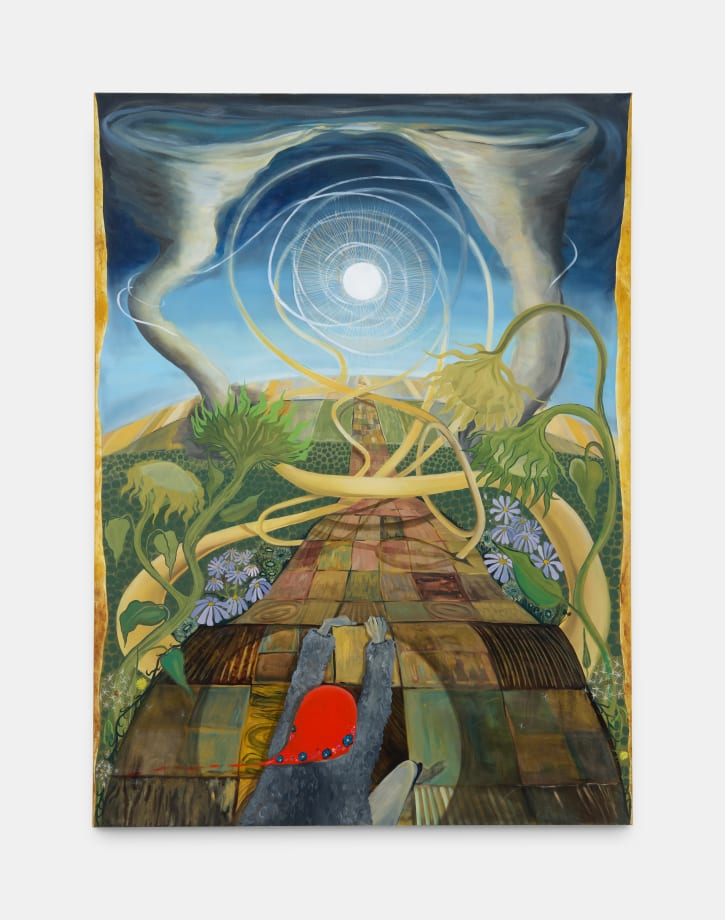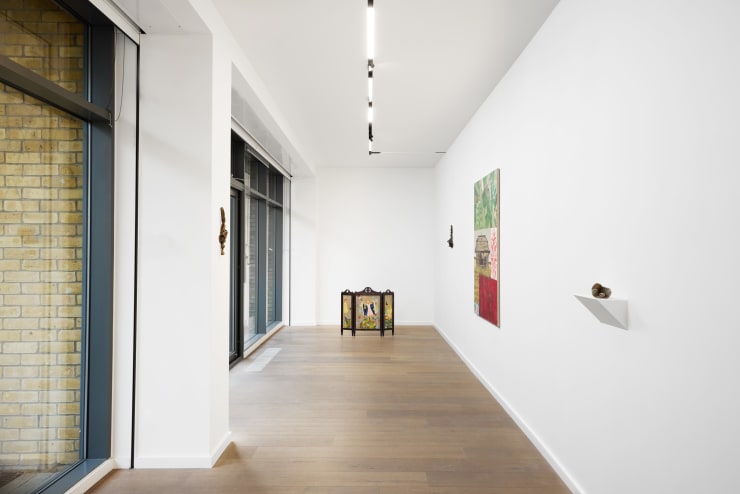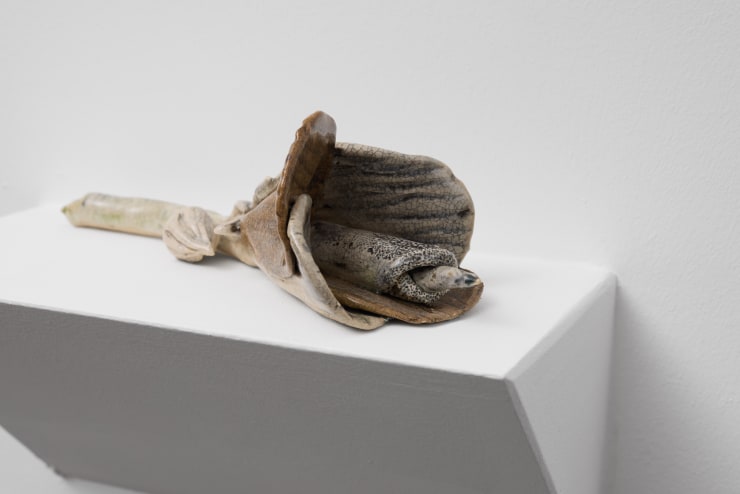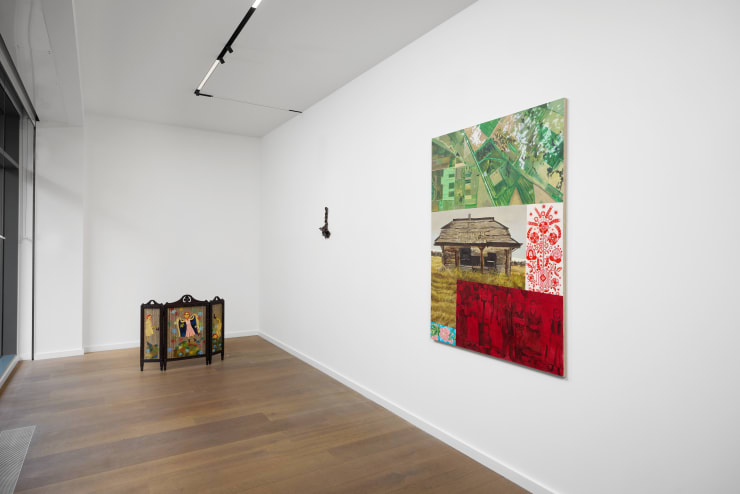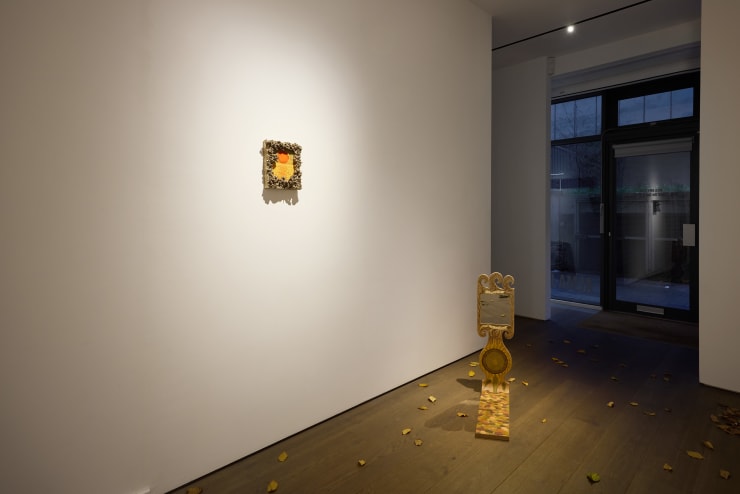Ayla Dmyterko: Ring Around the Sun & We Rage On
Current exhibition
Overview
Alma Pearl is pleased to present Ring Around the Sun & We Rage On, the debut solo exhibition in London by Ukrainian Canadian artist Ayla Dmyterko (b. 1988, Saskatchewan, Canada). This marks the artist’s first exhibition with the gallery following the announcement of her representation. An illustrated publication–the fourth in our series of limited-edition issues, features an essay by Daisy Lafarge (the text is available to download via this link)
The exhibition brings together new paintings, sculptures, ceramic hollyhocks, and moving image works, developed in part during Dmyterko’s residency at the Skowhegan School of Painting & Sculpture in Maine, as well as in Glasgow, where the artist is based, and in Saskatchewan, Canada. Drawing from ancestral memory, histories of possession and dispossession, and then acts of reparation, Dmyterko constructs visual narratives informed by eco-feminist perspectives and a profound engagement with both her community and other cross-cultural fragments.
Conceived as a total installation inspired in part by Svetlana Boym’s notion of the ‘off-modern’– which attends to forgotten or unfinished experiments or “roads not taken”, Dmyterko’s presentation embraces the element of the detour here enacted on a number of temporal and spatial levels involving familial, personal and broader cultural memory.
These works function as lost artifacts: meticulous bricolages of ritual, remembrance, and material storytelling. Rooted in Ukrainian and Slavic folklore, as well as agrarian and domestic craft traditions, Dmyterko reanimates past practices through a lens enriched by vernacular, pre-patriarchal and folkloric histories while also looking at the feminist and philosophical writings of Ewa Majewska, Ann Dufourmantelle, and Mikhail Bakhtin.
Positioning her practice within a lineage of recovery, Dmyterko describes this as a “tornado of semiotic warning.” In this framing, the visual and metaphorical semiotics of the tornado mobilise aesthetic and ethical forces to gather fragments of erased cultural memory, gesturing toward forms of repair. Fallen birch leaves — a tree rooted in Slavic folklore but also emblematic of the Canadian landscape — are scattered across the floor, symbolising the debris left behind by the forces of the tornado.
The exhibition takes its title from the nursery rhyme “Ring a Ring o' Roses”—a folk song and playground game steeped in pagan myth and folklore. In Dmyterko’s reinterpretation, the ring evokes the sun’s apocalyptic appearance during North American forest fire season—a moment of rupture unfolding within the quiet persistence of daily life. The title also gestures toward ‘solastalgia’, the distress wrought by environmental change and the looming anxiety of ecological collapse of one’s home environment.
The two-part sculptural piece, Like Fire on Water, takes its form from traditional L-shaped Slavic distaffs—objects once used by women while spinning wool. These distaffs, richly carved and painted, served both social and introspective functions: one side displayed outwardly in ornament and pride, the other turned inward as a reflective mirror. Dmyterko’s reinterpretations preserve this duality.
Other works, while inflected by humour, propose scenarios of turmoil and ecological collapse. In The Middle Distance, the artist subverts colonial posters that promoted emigration to Canada’s West in the early 1900’s, by reimagining the figure of the “spy girl,” a recurring stereotype in Cold War visual culture, here inhabiting and clinging onto a land that is about to be wiped away by tornadoes. Secrets Fall in the Forest features the same figure moving between woodland trees and playfully stylised, faux-naïve flowers. The scene is set within a found triptych frame, which may once have been part of an Orthodox iconostasis, lending the work a subtle echo of sacred imagery within a contemporary, whimsical context. The character of the spy-girl is then again performed by the artist in the single-channel video SK Eye (2025) here displayed on a vintage cube monitor – a reference to both obsolescence and utopia.
The collaborative single-channel video Dance of the Fated Furies (2025) extends these investigations into movement and myth. Filmed inside Saskatchewan's Ukrainian Cultural Centre where Dmyterko grew up, it revisits a scene from Zvenigora (1928) by Oleksander Dovzhenko—a cinematic kolymaka, or circle dance—while a theremin composition by Christina Masha Milinusic vibrates in counterpoint. Across its looping gestures, the video becomes both lament and invocation: an echo of exile and an assertion of cosmic continuity grounded within a diasporic context.
Some of these works are framed in reclaimed wood or cast bronze, with frames made through pouring wax, referencing a Ukrainian folk ritual brought to Canada by early settlers. Lastly, Dmyterko’s stoneware ceramics of hollyhocks stand as symbols of life's cycle, human degradation of nature, and diasporic longing.
In Ring Around the Sun & We Rage On, Ayla Dmyterko binds together the material, the metaphysical, the domestic and the diasporic. Her practice becomes an act of cultural and spiritual archaeology—an attempt to resuscitate not only what was lost, but the rituals of remembrance as a means of re–shaping a future.
This exhibition is made possible in part by the generous support of the Canada Council.
Installation Views
Publications
